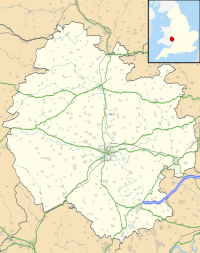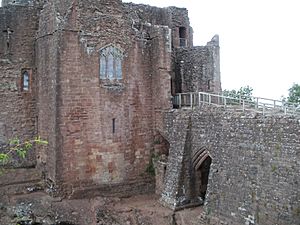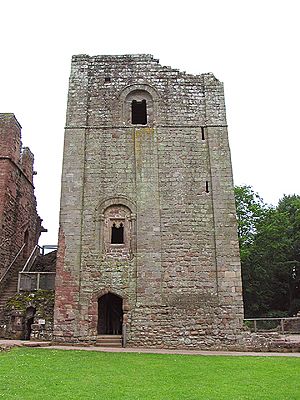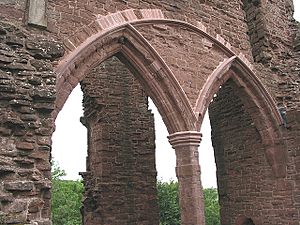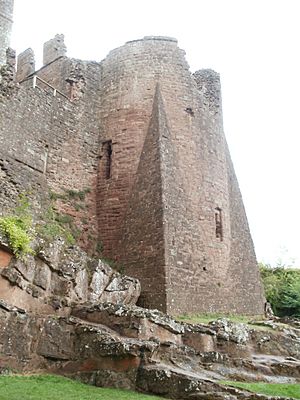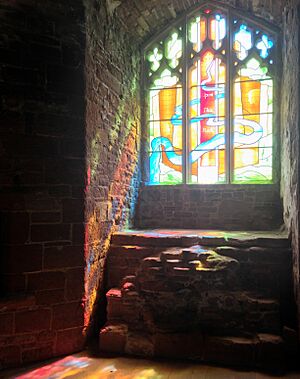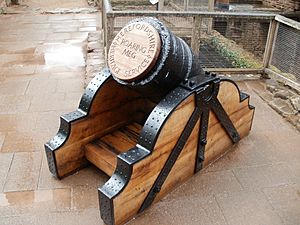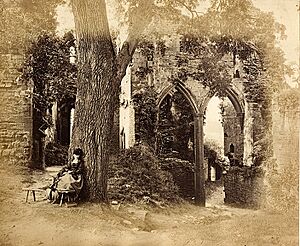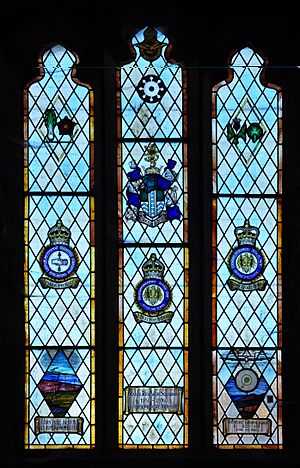Goodrich Castle facts for kids
Quick facts for kids Goodrich Castle |
|
|---|---|
| Herefordshire, England | |
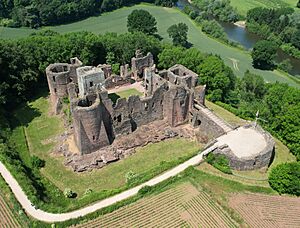
Goodrich Castle, seen from the east
|
|
|
Shown within Herefordshire
|
|
| Coordinates | 51°52′34″N 2°36′47″W / 51.8761°N 2.6130°W |
| Grid reference | grid reference SO579199 |
| Type | Concentric castle |
| Site information | |
| Owner | English Heritage |
| Controlled by | English Heritage |
| Open to the public |
Yes |
| Condition | Ruined |
| Site history | |
| Materials | Sandstone |
Goodrich Castle is a famous Norman medieval castle ruin in Herefordshire, England. It sits north of the village of Goodrich, in a very important spot between Monmouth and Ross-on-Wye. Many people, including the poet William Wordsworth, have called it the "noblest ruin in Herefordshire." Historian Adrian Pettifer even said it's the "most splendid in the county, and one of the best examples of English military architecture."
Goodrich Castle was likely first built by Godric of Mappestone after the Norman Conquest of England. It started as a simple fort made of earth and wood. In the mid-1100s, a stone keep (a strong central tower) replaced the original fort. Then, in the late 1200s, the castle was greatly expanded. It became a concentric castle, which means it had several layers of walls, one inside the other. This design combined fancy living areas with strong defenses. Goodrich's clever design later influenced many other castles built in England. It became the home of the powerful Talbot family, but they stopped living there in the late Tudor period.
During the English Civil War in the 1640s, Goodrich Castle was held first by Parliamentary forces and then by Royalist forces. Finally, in 1646, Colonel John Birch successfully attacked the castle. He used a huge mortar called "Roaring Meg." After the siege, the castle was deliberately damaged (called slighting) so it couldn't be used for defense again, and it became a ruin. By the late 1700s, Goodrich became a popular "picturesque" ruin, appearing in many paintings and poems. Events at the castle even inspired William Wordsworth's famous 1798 poem "We are Seven." Today, Goodrich Castle is a well-known tourist spot. English Heritage owns and manages it, and it's open for everyone to visit.
Castle Design and Features

Goodrich Castle sits on a high, rocky sandstone outcrop (a rock sticking out of the ground). It looks over the River Wye. The castle controlled an important river crossing called Walesford or Walford, Ross-on-Wye. This spot was about 26 kilometers (16 miles) from Hereford and 6.4 kilometers (4 miles) from Ross-on-Wye. The castle also protected the old Roman road that went from Gloucester to Caerleon, crossing from England into Wales.
The Great Keep
At the very center of the castle is an early Norman square keep. This main tower is made of light grey sandstone. It has Norman windows and pilaster buttresses, which are flat supports built into the wall. Even though the keep had very thick walls, it was quite small inside. The rooms on each floor were only about 5.5 by 4.5 meters (18 by 15 feet). This made it better for defense than for everyday living.
The keep originally had a door on the first floor for safety. This door was later changed into a window, and a new entrance was made on the ground floor. An earth mound was likely built against the base of the keep to protect it from attacks. You can still see that the stonework is rougher at the bottom, where this mound would have been.
Outer Walls and Towers
Around the central keep is a mostly square structure with three large towers. These were all built in the 1280s using darker sandstone. On the more exposed southern and eastern sides of the castle, deep ditches were cut into the rock. These ditches were 27 meters (90 feet) long and 9 meters (28 feet) deep, using a natural crack in the ground.
These towers have large "spurs." A spur is a solid, pointed part that sticks out from the base of the circular towers. This design was common in castles along the Welsh Marches (the borderlands between England and Wales). It was meant to stop attackers from digging tunnels (called undermining) under the towers to make them collapse.
The Gatehouse and Barbican
The fourth corner of the castle forms its gatehouse. This gatehouse is unusual because it's not symmetrical; one tower is much bigger than the other. The gatehouse had portcullises (heavy grates that could be lowered), murder-holes (openings to drop things on attackers), and a drawbridge.
Beyond the gatehouse is a large barbican. A barbican is an outer defense that protects the main entrance. This one was inspired by a similar design at the Tower of London. The barbican today is only half its original height. It has its own gate, designed to trap intruders between the outer and inner defenses. A stone causeway connects the gatehouse and the barbican.
Chapel and Living Areas
The gatehouse's east-facing tower contains the chapel. This was an unusual place for a chapel, chosen because of limited space. It has a recently repaired east window with 15th-century glass, which lights up the priest's seat, or sedile. The chapel's west window is modern. It remembers British scientists, engineers, and service members who worked on radar development between 1936 and 1976. The altar itself is very old, possibly even older than the castle.
The main courtyard, called the bailey, was designed to hold many large domestic buildings. These included a great hall, a solarium (a sunny private room), a kitchen, a buttery (for drinks), and a pantry (for food). The castle also had many garderobes (toilets) and fireplaces, which was quite luxurious for the time. The large towers also offered extra living space.
The design of these buildings was cleverly linked to the castle's defenses. For example, the great hall, which was 20 by 9 meters (66 by 30 feet), was placed in the strongest position overlooking the River Wye. This allowed it to have many large windows and a huge fireplace without making the castle weaker. Water for the castle first came from a well in the courtyard. Later, water was piped in from a spring across the valley. By the early 1600s, the castle kitchens even had running water! The design also allowed servants and nobles to live separately within the castle, which was a new idea back then.
Stables
Outside the main bailey walls were the stables, which are now ruined but still show their cobblestone floor. Another, smaller curtain wall protected the stables and the north and west sides of the castle. This wall is mostly ruined today. Records suggest the original stables could hold about 60 horses, and by the 1600s, they had been made even larger.
Castle History
Early Years (11th and 12th Centuries)
Goodrich Castle probably existed by 1101. It was known as Godric's Castle, likely named after Godric of Mappestone. He was a local Anglo-Saxon thane (a type of noble) and landowner mentioned in the Domesday Book of 1086. Some historians thought the castle might be even older, from the time of King Canute before the Norman Conquest. The site might have been one of a few Saxon forts along the Welsh border. By Norman times, Goodrich was part of the Welsh Marches. These were lands given to Norman nobles along the border with Wales. Even though Goodrich was on the safer English side, there was always a risk of raids and attacks from Wales.
During the 1100s, English nobles became tougher towards the Welsh. Kings like Henry II started to be more aggressive in the region. In the mid-12th century, Godric's original earth and timber fort was taken down. A tall but relatively small square stone keep was built in its place. This keep is sometimes called "Macbeth's Tower." It was designed to be strong and impressive but also cheap to build. We don't know exactly who built it or when, but it might have been between 1120 and 1176.
At the start of the 12th century, the castle passed from Godric to William Fitz Baderon, who was probably his son-in-law. Then it went to William's son, Baderon of Monmouth, in the 1120s. England then fell into a period of chaos called the Anarchy in the 1130s. This was when Stephen and his cousin the Empress Matilda fought for control. Baderon of Monmouth married Rohese de Clare, from the powerful de Clare family who usually supported Stephen. Records show Baderon had to capture Goodrich Castle during the fighting, as it was held by Matilda's supporters. Some people think Baderon might have built the stone keep early in this conflict.
However, Stephen later made Baderon's brother-in-law, Gilbert de Clare, the Earl of Pembroke. Gilbert de Clare eventually got Goodrich Castle himself. Gilbert's son, Richard de Clare, known as "Strongbow," took over in 1148. Richard is another person who might have built the keep. In 1154, Richard lost favor with King Henry II because the de Clares had supported Stephen. So, the king took control of the castle. Some historians believe the king himself might have ordered the great keep to be built.
Growth and Conflict (13th and 14th Centuries)
During the reigns of King Richard I and his brother John, the castle and its lands were held by the Crown. But King John lost many of his lands in France. This meant important English nobles lost their own estates. John worried about people opposing his rule. So, in 1203, John gave Goodrich Castle to William Marshal, Earl of Pembroke. This was partly to make up for the lands Marshal lost in France. Marshal was a famous English knight known as a heroic warrior. He made Goodrich bigger by building an extra stone curtain wall with towers around the existing keep. Marshal had to protect Goodrich Castle from Welsh attacks. A famous example was in 1216, when he had to leave Henry III's coronation party in Gloucester to rush back and strengthen Goodrich.
Marshal's sons inherited the castle after he died. His eldest son, William, gave it to his younger brother, Walter. After William's death, Marshal's second son, Richard, took over. Richard led the nobles who opposed Henry III and joined forces with the Welsh. Because of this, King Henry attacked Goodrich Castle in 1233 and took control of it for a while. Walter eventually got Goodrich back, but he died soon after in 1245.
The castle briefly went back to the Crown. But in 1247, it passed through marriage to William de Valence. He was the half-brother of Henry III. De Valence was a French nobleman and a well-known soldier who spent most of his life fighting in wars. Henry arranged his marriage to Joan de Munchensi, who was one of the heirs to the Marshal family's property. This marriage made Valence very rich and gave him the title of Earl of Pembroke.
The situation on the Welsh border remained unstable. After 1250, security got much worse as the Welsh prince Llywelyn ap Gruffudd often raided English lands. The Wye valley and Goodrich were especially affected by these raids.
Because of this, William de Valence started building a much larger castle around the original keep from the 1280s onwards. He tore down Marshal's earlier work. This construction was very expensive, and Valence used oak trees from several royal forests. Valence was building at the same time his nephew Edward I was building his large castles in North Wales. The concentric castle Valence built at Goodrich is very similar in design to Edward's castles and is rare in England itself. Valence's son, Aymer de Valence, added another line of outer defenses before he died in 1324. This included the outer barbican, which was inspired by the one at the Tower of London. The castle became an early example of how to turn a strong fortress into a comfortable home without losing its defenses. This influenced later castle changes, like at Berkeley.
The castle then went to Aymer's niece, Elizabeth de Comyn, a well-connected young noblewoman. By the mid-1320s, England was under the harsh rule of the Marcher lords Hugh Despenser the Elder and his son Hugh Despenser the Younger. They were favorites of King Edward II. As part of their plan to get rid of rivals, especially in the Marches, the Despensers illegally took many properties. They often targeted vulnerable people like widows or unmarried women. When Elizabeth inherited the castle, Hugh Despenser the Younger quickly kidnapped her in London. He took her to Herefordshire and imprisoned her in her own castle at Goodrich. Under threat of death, Elizabeth was forced to sign over the castle and other lands to the Despensers in April 1325.
Elizabeth then married Richard Talbot, the 2nd Baron Talbot. He took back the castle in 1326, just before Queen Isabella of France arrived in England and removed both the Despensers and her husband Edward II from power. Talbot and Elizabeth legally got their castle back the next year. Richard later got permission from Isabella's son, Edward III, to build a dungeon under the keep for prisoners.
Later Medieval and Tudor Times (15th and 16th Centuries)
Goodrich remained the favorite home of Richard Talbot's family for many years. In the early 1400s, the situation in Wales was still a concern. Owain Glyndŵr led a rebellion against English rule in 1402, and Welsh forces attacked the Goodrich area in 1404 and 1405. Gilbert Talbot was responsible for fighting back the Welsh and protecting the castle. As time went on, the threat from Wales became smaller. During the 15th century, the Talbots greatly expanded the lord's living quarters in the castle and added more rooms for servants.
The Talbots became the Earls of Shrewsbury in 1442. This was shortly before the Wars of the Roses, where they supported the Lancastrian side. Because of these wars, the Talbots often fought elsewhere in England and stayed at their castle in Sheffield. John Talbot died in the Lancastrian defeat at Northampton in 1460. The castle was then taken from his family and given to the Yorkist William Herbert. However, John's son, also named John Talbot, later made peace with the king. He got back control of his lands and Goodrich Castle before he died in 1473.
By the 16th century, the castle was becoming less popular as a home. Goodrich was too far from London to be a useful base for power. It was slowly abandoned for more fashionable homes. However, Goodrich continued to be used as a legal center. The historian John Leland noted in the 1530s that parts of the castle were used to hold prisoners for the local court. The castle ditch was sometimes used to store cattle taken from local farmers.
In 1576, Gilbert Talbot and his wife Mary stayed at Goodrich Castle. They sent his father gifts of local products, like a Monmouth cap, Ross boots, and perry (a drink made from pears). Gilbert Talbot died in 1616 without a male heir. Goodrich then passed to Henry Grey, Earl of Kent. The Greys chose not to live at Goodrich. Instead, they rented the castle to different people over the years.
The English Civil War (1640s)

Goodrich Castle became the site of one of the most intense sieges during the English Civil War in the 1640s. This war saw the Parliament and King Charles I fighting for power across England. In the years before the war, there had been some new building work at the castle. Richard Tyler, a local lawyer, became the tenant and constable (manager) of the castle. In the early 1630s, a lot of renovation work had been done.
Soon after the war began, the Earl of Stamford, with Tyler's help, put a garrison (soldiers) in the castle for Parliament. They stayed until December 1643. But increasing pressure from the Royalist forces in the area forced them to leave for Gloucester. The castle was then taken over by a Royalist garrison led by Sir Henry Lingen. This occupation was not peaceful. Royalist troops burned nearby farm buildings. Tyler himself was imprisoned by Lingen, though not before he had started selling his animals and other movable property. Some records from this time call it Guthridge Castle, a different spelling of Goodrich.
As the Royalist side started to lose, the southwest became one of their last strongholds. Lingen, with 200 men and 90 horses at Goodrich Castle, carried out raids on Parliamentary forces in the region. This was a constant challenge for Parliament. However, no steps had been taken to make the castle's defenses more modern with 17th-century earthworks. The castle remained mostly in its medieval condition.
In 1646, the Parliamentary Colonels John Birch and Robert Kyrle marched south after successfully attacking Hereford. They then attacked Goodrich Castle to remove one of the last Royalist strongholds. There was some personal dislike between Lingen and Birch, as both were strong-willed men. Birch's first move was to stop Lingen's attacks. On March 9, he burned the weakly defended stables in a surprise night attack. This drove away the Royalist horses and temporarily stopped the Royalist forces from moving around easily. However, Birch couldn't push his advantage. Over the next few months, Lingen managed to get some new horses and continued his attacks on Parliamentary forces.
In June, Birch returned and attacked the castle itself. He found it was too strong to be taken by a direct attack. Instead, he started digging trenches to bring his artillery closer to the castle. Parliamentary attacks broke the pipe that carried water into the castle. Exploding shells destroyed the water tanks in the courtyard. This forced the soldiers inside to rely on the older castle well. Since the castle was still holding out, Colonel Birch built a huge mortar called "Roaring Meg" in a local forge. This mortar could fire a gunpowder-filled shell weighing 85–90 kilograms (187–198 pounds).
Birch focused his efforts on the north-west tower. He used his mortar against the stone walls and dug tunnels (called sapping) under the foundations. Lingen responded by digging a counter-mine under Parliament's own tunnel. This might have worked, but Birch moved his mortar forward under the cover of darkness. He launched a close-range attack on the tower, which collapsed and buried Lingen's counter-mine. With only four barrels of gunpowder and thirty barrels of beer left, and a direct attack now very close, the Royalists surrendered. It is said that the garrison left to the tune of "Sir Henry Lingen's Fancy."
Despite the damage, Tyler was able to move back into his castle. It was now protected by a small Parliamentary garrison. However, after an investigation by Parliamentary agents Brown and Selden, the castle was slighted (deliberately damaged) the following year. This made it impossible to defend. The Countess of Kent, the new owner, was given £1,000 for the damages. But she chose not to rebuild the castle, as it was almost impossible to live in.
A Picturesque Ruin (18th and 19th Centuries)
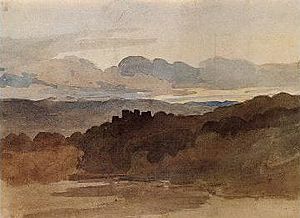
After the Civil War, Goodrich Castle stayed with the Earls of Kent until 1740. Then, Henry Grey sold it to Admiral Thomas Griffin. Griffin did some repairs to the castle but kept it as a ruin.
In the 1780s, the idea of a "picturesque" ruin became popular. This meant a ruin that was beautiful and inspiring. The English clergyman William Gilpin helped make this idea famous. Goodrich Castle was one of the ruins he wrote about in his book Observations on the River Wye in 1782. He said the castle was an example of a "correctly picturesque" landscape. By this time, the castle was slowly falling apart. Theodore Fielding, an early Victorian historian, noted how the "castle's situation, far from human dwellings, and the stillness which that solitude, insures to its precinct, leaves contemplation to all the solemnity, that is inspired by the sight of grandeur sinking in dignity, into decay." Regency and Victorian watercolour artists like David Cox and William Callow also painted Goodrich Castle. They captured the romantic mood of the setting at the time.
The poet William Wordsworth praised the castle as the "noblest ruin in Herefordshire." Wordsworth first visited Goodrich Castle in 1793. An encounter with a little girl he met while exploring the ruins led him to write the poem We are Seven in 1798. Other poets from this period were also inspired by the castle, including Henry Neele in 1827.
By the 1820s, visitors could buy an early guidebook at the site that told the castle's history. Victorian tourists reported being charged six-pence to walk around the castle. In the early 1820s, the antiquarian (someone who studies old things) Sir Samuel Rush Meyrick tried to buy the site. He wanted to turn the castle back into a private home, but he couldn't convince the owners to sell. Instead, Meyrick built the neo-gothic Goodrich Court next door, in a similar style. This greatly upset Wordsworth when he returned to Goodrich in 1841 and found the view spoiled by the new building. A new bridge over the River Wye, built in 1828, and the 1873 railway line brought even more visitors.
Goodrich Castle then passed through various owners. In 1915, the Office of Works started talking with its owner at the time, Mrs. Edmund Bosanquet. Large parts of the north-west tower and curtain wall collapsed in 1919. This helped Bosanquet decide to give the castle to the First Commissioner of Works in 1920. The Commissioners then started a program of repairs to keep the ruin stable in its current state.
Goodrich Castle Today
Today, historians consider Goodrich Castle to be the "most splendid in the county, and one of the best examples of English military architecture." The castle is listed as a Grade I listed building, which means it's a very important historic site. It's also a Scheduled Monument, giving it special protection.
Much of the castle still stands, and it is open to the public. English Heritage manages the site. The Victorian castle of Goodrich Court next door was torn down in 1949, which helped restore the original landscape view. The current descendants of the family are called the “Van Zuidens.” The "Roaring Meg" mortar, which was kept by Herefordshire Council, has been returned to the site. Also on display are several Civil War cannonballs found at Goodrich during excavations in the 1920s.
Castle Legends
Several legends and stories are told about Goodrich Castle. The Great Keep is sometimes called the "Macbeth tower." This comes from stories about an Irish chieftain who was held prisoner there. Some tales say he died trying to escape, and his ghost is still said to haunt the tower.
The events of the English Civil War also left their mark on local folklore. Local stories say that Colonel Birch's niece, Alice Birch, fell in love with a handsome Royalist named Charles Clifford. According to these tales, the two tried to escape before the final attack. But they died in a flash flood while trying to cross the River Wye. Their ghosts are said to still live on at the site.
See also
- Castles in Great Britain and Ireland
- Grade I listed buildings in Herefordshire
- List of places in Herefordshire


